Siddi
The Siddi (pronounced [sɪd̪d̪i]), also known as Sidi, Siddhi, Sheedi or Habshi, are an ethnic group inhabiting India and Pakistan. Members are descended from the Bantu peoples of Southeast Africa. Some were merchants, sailors, indentured servants, slaves and mercenaries.[5] The Siddi population is currently estimated at around 270,000–350,000 individuals, with Karnataka, Gujarat and Hyderabad in India and Makran and Karachi in Pakistan[6] as the main population centres.[7] Siddis are primarily Muslims, although some are Hindus and others belong to the Catholic Church.[8]
.jpg.webp) Siddi community in India | |
| Total population | |
|---|---|
| 270,000–350,000 (estimated) | |
| Regions with significant populations | |
| 250,000[1] | |
| 25,000–70,000[2][3] | |
| Karnataka | 10,477 (2011 census)[4] |
| Gujarat | 8,661[4] |
| Daman and Diu | 193[4] |
| Goa | 183[4] |
| Languages | |
| Hindi, Urdu, Balochi, Sindhi, Kannada, Gujarati, Marathi, Konkani, Swahili, Telugu | |
| Religion | |
| Predominantly: Islam (Sufi, Sunni); minority: Christianity (Catholic), Hinduism | |
Etymology

There are conflicting hypotheses on the origin of the name Siddi. One theory is that the word derives from sahibi, an Arabic term of respect in North Africa, similar to the word sahib in modern India and Pakistan.[9] A second theory is that the term Siddi is derived from the title borne by the captains of the Arab vessels that first brought Siddi settlers to India; these captains were known as Sayyid.[10]
Similarly, another term for Siddis, habshi, is held to be derived from the common name for the captains of the Northeast African Abyssinian ships that also first delivered Siddi slaves to the subcontinent.[10] Siddis are also sometimes referred to as Afro-Indians.[11][12][13] Siddis were referred to as Zanji by Arabs; in China, various transcriptions of this Arabic word were used, including Xinji (辛吉) and Jinzhi (津芝).[14][15][16][17]
History
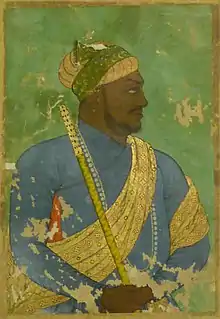
The first Siddis are thought to have arrived in India in 628 AD at the Bharuch port. Several others followed with the first Arab Islamic conquest of the subcontinent in 712 AD.[18] The latter group are believed to have been soldiers with Muhammad bin Qasim's Arab army, and were called Zanjis.
Some Siddis escaped slavery to establish communities in forested areas, and some also established the small Siddi principalities of Janjira State on Janjira Island and Jafarabad State in Kathiawar as early as the twelfth century. A former alternative name of Janjira was Habshan (i.e., land of the Habshis). In the Delhi Sultanate period prior to the rise of the Mughals in India, Jamal-ud-Din Yaqut was a prominent Siddi slave-turned-nobleman who was a close confidant of Razia Sultana (1235–1240 CE). Although this is disputed, he may also have been her lover, but contemporary sources do not indicate that this was necessarily the case.[19]
Siddis were also brought as slaves by the Deccan Sultanates. Several former slaves rose to high ranks in the military and administration, the most prominent of which was Malik Ambar.
Later the Siddi population was added to via Bantu peoples from Southeast Africa that had been brought to the Indian subcontinent as slaves by the Portuguese.[5] Later most of these migrants became Muslim and a small minority became Hindu.[9] The Nizam of Hyderabad also employed African-origin guards and soldiers.[20][21]

India
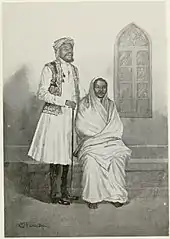
Harris (1971) provides an historical survey of the eastward dispersal of slaves from Southeast Africa to places like India.[22] Hamilton (1990) argues that Siddis in South India are a significant social group whose histories, experiences, cultures, and expressions are integral to the African Diaspora and thus, help better understand the dynamics of dispersed peoples. More recent focused scholarship argues that although Siddis are numerically a minority, their historic presence in India for over five hundred years, as well as their self-perception, and how the broader Indian society relates to them, make them a distinct Bantu/Indian.[23] Historically, Siddis have not existed only within binary relations to the nation state and imperial forces. They did not simply succumb to the ideologies and structures of imperial forces, nor did they simply rebel against imperial rule.[24] The Siddi are recognized as a scheduled tribe in 3 states and 1 union territory: Goa, Gujarat, Karnataka and Daman and Diu.[25]
Hyderabad
In the 18th century, a Siddi community was established in Hyderabad State by the Arab Siddi diaspora, who have frequently served as cavalry guards to the Asif Jahi Nizam of Hyderabad's army. The Asif Jahi rulers patronised them with rewards and the traditional Marfa music gained popularity and would be performed during official celebrations and ceremonies.[26][27][28] The Siddis of Hyderabad have traditionally resided in the A.C. Guards (African Cavalry Guards) area near Masjid Rahmania, known locally as Siddi Risala in the city Hyderabad.
Gujarat
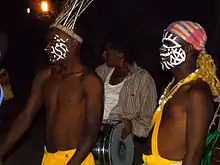
Supposedly presented as slaves by the Portuguese to the local Prince, Nawab of Junagadh, the Siddis also live around Gir Forest National Park and Wildlife sanctuary.[29] On the way to Deva-dungar is the quaint village of Sirvan, inhabited entirely by Siddis. They were brought 300 years ago from Portuguese colonial territories for the Nawab of Junagadh. Today, they follow very few of their original customs, with a few exceptions like the traditional Dhamal dance.[30]
Although Gujarati Siddis have adopted the language and many customs of their surrounding populations, some of their Bantu traditions have been preserved. These include the Goma music and dance form, which is sometimes called Dhamaal (Gujarati: ધમાલ, fun).[31] The term is believed to be derived from the Ngoma drumming and traditional dance forms of the Bantu people inhabiting Central, East and Southern Africa.[32] The Goma also has a spiritual significance and, at the climax of the dance, some dancers are believed to be vehicles for the presence of Siddi saints of the past.[33]
Goma music comes from the Kiswahili word "ngoma", which means a drum or drums. It also denotes any dancing occasion where traditional drums are principally used.
The majority of the Siddis in Gujarat are Muslims (98.7%), with very few following Hinduism (1%).[34]
Karnataka
The Siddis of Karnataka (also spelled Siddhis) are an ethnic group of mainly Bantu descent that has made Karnataka their home for the last 400 years.[5] There is a 50,000-strong Siddhi population across India, of which more than a third live in Karnataka. In Karnataka, they are concentrated around Yellapur, Haliyal, Ankola, Joida, Mundgod and Sirsi taluks of Uttara Kannada and in Khanapur of Belgaum and Kalaghatagi of Dharwad district. Many members of the Siddis community of Karnataka had migrated to Pakistan after independence and have settled in Karachi, Sindh. It has been reported that these Siddis believe that Barack Obama shares their genepool.They wished to gift him and honour him on his visit to India in 2010.[35]
A plurality of the Siddis in Karnataka follow Hinduism (41.8%), followed by Islam (30.6%) and Christianity (27.4%).[36]
Pakistan
In Pakistan, locals of Bantu descent are called "Sheedi". They live primarily along the Makran in Balochistan, and lower Sindh.[6] The estimated population of Sheedis in Pakistan is 250,000.[37] In the city of Karachi, the main Sheedi centre is the area of Lyari and other nearby coastal areas. Technically, the Sheedi are a brotherhood or a subdivision of the Siddi. The Sheedis are divided into four clans, or houses: Kharadar Makan, Hyderabad Makan, Lassi Makan and Belaro Makan.[38] The Sufi saint Pir Mangho is regarded by many as the patron saint of the Sheedis, and the annual Sheedi Mela festival, is the key event in the Sheedi community's cultural calendar.[38] Some glimpses of the rituals at Sidi/Sheedi Festival 2010 include visit to sacred alligators at Mangho pir, playing music and dance.[39] Clearly, the instrument, songs and dance appear to be derived from Africa.[40]
In Sindh, the Sheedis have traditionally intermarried only with people such as the Mallahs (fisherpeople), Khaskheli (laborers), Khatri (dyeing community) and Kori (clothmakers).
Famous Sheedis include the historic Sindhi army leader Hoshu Sheedi[41] and Urdu poet Noon Meem Danish.[42][43] Sheedis are also well known for their excellence in sports, especially in football and boxing. Qasim Umer is one cricketer who played for Pakistan in 80s. The musical anthem of the ruling Pakistan Peoples Party, "Bija Teer", is a Balochi song in the musical style of the Sheedis with Black African style rhythm and drums.[44] Younis Jani is a popular Sheedi singer famous for singing an Urdu version of the reggaeton song "Papi chulo... (te traigo el mmmm...)."[45]
Sindh
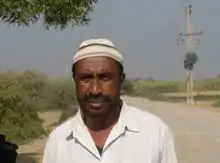
Sheedis are largely populated in different towns and villages in lower Sindh. They are very active in cultural activities and organise annual festivals, like, Habash Festival, with the support of several community organisations. In the local culture, when there is a dance it is not performed by some selected few and watched idly by others but it is participated by all the people present there, ending difference between the performers and the audience.[46]
Sheedis in Sindh also proudly call themselves the Qambranis, (Urdu: قمبرانی ; Sindhi: قمبراڻي), in reverence to Qambar, the freed slave of Ali, the fourth Rashid Caliph.[5][47] Tanzeela Qambrani became the first Sheedi woman to be elected as the member of Provincial Assembly of Sindh in 2018 Pakistani general election.[48][49]
Genetics
Recent advances in genetic analyses have helped shed some light on the ethnogenesis of the Siddi. Genetic genealogy, although a novel tool that uses the genes of modern populations to trace their ethnic and geographic origins, has also helped clarify the possible background of the modern Siddi.
Y DNA
A Y-chromosome study by Shah et al. (2011) tested Siddi individuals in India for paternal lineages. The authors observed the E1b1a1-M2 haplogroup, which is frequent among Bantu peoples, in about 42% and 34% of Siddis from Karnataka and Gujarat, respectively. Around 14% of Siddis from Karnataka and 35% of Siddis from Gujarat also belonged to the Sub-Saharan B-M60. The remaining Siddis had Indian associated or Near Eastern-linked clades, including haplogroups P, H, R1a-M17, J2 and L-M20.[50]
Thangaraj (2009) observed similar, mainly Bantu-linked paternal affinities amongst the Siddi.[51]
Qamar et al. (2002) analysed Makrani Siddis in Pakistan and found that they instead predominantly carried Indian-associated or Near Eastern-linked haplogroups. R1a1a-M17 (30.30%), J2 (18.18%) and R2 (18.18%) were their most common male lineages.[52] Only around 12% carried Africa-derived clades, which mainly consisted of the archaic haplogroup B-M60, of which they bore the highest frequency of any Pakistani population Underhill et al. (2009) likewise detected a relatively high frequency of R1a1a-M17 (25%) subclade among Makrani Siddis.[53]
mtDNA
According to an mtDNA study by Shah et al. (2011), the maternal ancestry of the Siddi consists of a mixture of Bantu-associated haplogroups and Indian-associated haplogroups, reflecting substantial female gene flow from neighbouring Indian populations. About 53% of the Siddis from Gujarat and 24% of the Siddis from Karnataka belonged to various Bantu-derived macro-haplogroup L subclades. The latter mainly consisted of L0 and L2a sublineages associated with Bantu women. The remainder possessed Indian-specific subclades of the Eurasian haplogroups M and N, which points to recent admixture with autochthonous Indian groups.[5]
Autosomal DNA
Narang et al. (2011) examined the autosomal DNA of Siddis in India. According to the researchers, about 58% of the Siddis' ancestry is derived from Bantu peoples. The remainder is associated with locals North and Northwest Indian populations, due to recent admixture events.[54]
Similarly, Shah et al. (2011) observed that Siddis in Gujarat derive 66.90%–70.50% of their ancestry from Bantu forebears, while the Siddis in Karnataka possess 64.80%–74.40% such Southeast African ancestry. The remaining autosomal DNA components in the studied Siddi were mainly associated with local South Asian populations. According to the authors, gene flow between the Siddis' Bantu ancestors and local Indian populations was also largely unidirectional. They estimate this admixture episode's time of occurrence at within the past 200 years or eight generations.[5]
However, Guha et al. (2012) observed few genetic differences between the Makrani of Pakistan and adjacent populations. According to the authors, the genome-wide ancestry of the Makrani was essentially the same as that of the neighboring Indo-European speaking Balochi and Dravidian-speaking Brahui.[55]
Culture
The culture of the Siddi is indicative of both the length of time they have been in India and their East African origins. While they have assimilated in many ways to the dominant culture,[56] they have also kept some ancestral practices especially in music and dance.[57] Like other ethnic groups separated by geography, there are both differences and similarities in cultural practices among the Siddi.
Generally, the Siddi primarily associate and marry members of their own communities.[58] It is rare for the Siddi to marry outside of their communities although in Pakistan a growing number of the Sheedi (as they are known there) intermarry as a way to dilute their African lineage and reduce racial discrimination and prejudice.[59]
Siddi communities, although classified as a tribe by the Indian government (in order to receive benefits), primarily live in agricultural communities where men are responsible for the farming and women are responsible for the home and children.[60] Outside of their communities, men also tend to be employed as farm hands, drivers, manual laborers, and security guards.[61]
When it comes to dress, women and men dress in typical Indian fashion. For instance, Siddi women wear colorful saris and don bindis. Men wear what is generally appropriate for men in their communities.
Like in other aspects of life, the Siddi have adopted the common dietary practices of the dominant society. But, an example of a staple meal would be a large portions of rice with dal and pickles.[62]
Athletics has been an important part of the Siddi community and has been a means to uplift youth and a means of escape from poverty and discrimination.[63][64][65]
Famous Siddis or Sheedis
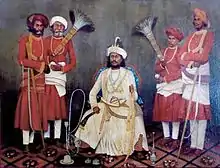
- Shantaram Siddi, member of the Karnataka Legislative Council
- Jamal-ud-Din Yaqut (died 1240), confidante of Razia Sultana
- Yakut Khan (died 1733), naval admiral
- Hoshu Sheedi (1801-1843), Sindhi commander
- Noon Meem Danish (born 1958), Urdu poet
- Nawabs of Janjira State
- Nawabs of Sachin State
- Juje Siddi (born 1973), former Indian national football team and Salgaocar SC goalkeeper[66]
- Abdul Rashid Qambrani (born 1975), Pakistani boxer
- Malik Ambar (1548-1626), regent of the Ahmadnagar kingdom
- Abid Brohi, Pakistani Balochi rapper
- Sidi Sayyid, credited with the building of the Sidi Saiyyed Mosque, and who served in the retinue of Bilal Jha Jhar Khan, an Abyssinian general in the army of the last sultan of Gujarat[67]
- Tanzeela Qambrani (born 1979), Pakistani politician, member of the Provincial Assembly of Sindh
- Zamor (1762-1820), Jacobite French revolutionary of possibly Siddi origin from Bengal. [68] He, as a boy of 11, was taken from Chittagong, Bengal Subah, Mughal Empire (now Bangladesh) by slave traders.
Films and books
- From Africa...To Indian Subcontinent: Sidi Music in the Indian Ocean Diaspora (2003) by Amy Catlin-Jairazbhoy, in close collaboration with Nazir Ali Jairazbhoy and the Sidi community.
- Mon petit diable (My Little Devil) (1999) was directed by Gopi Desai. Om Puri, Pooja Batra, Rushabh Patni, Satyajit Sharma.
- Razia Sultan (1983), an Indian Urdu film directed by Kamal Amrohi, is based on the life of Razia Sultan (played by Hema Malini) (1205–1240), the only female Sultan of Delhi (1236–1240), and her speculated love affair with the Abyssinian slave Jamal-ud-Din Yakut (played by Dharmendra). He was referred to in the movie as a habshee.
- A Certain Grace: The Sidi, Indians of African Descent by Ketaki Sheth, Photolink, 2013.[69]
- Shaping Membership, Defining Nation: The Cultural Politics of African Indians in South Asia (2007) by Pashington Obeng.
- Inside a Lost African Tribe Still Living in India Today (2018) by Asha Stuart
See also
References
- name="dawn.com">Paracha, Nadeem (26 August 2018), "Smokers’ corner: Sindh's African roots ", Dawn.
- The Sidi Project.
- "A-11 Individual Scheduled Tribe Primary Census Abstract Data and its Appendix". Census of India 2011. Office of the Registrar General & Census Commissioner, India. Retrieved 24 March 2017.
- Shah, Anish M.; et al. (15 July 2011). "Indian Siddis: African Descendants with Indian Admixture". American Journal of Human Genetics. 89 (1): 154–161. doi:10.1016/j.ajhg.2011.05.030. PMC 3135801. PMID 21741027.
- Abbas, Zaffar (13 March 2002). "Pakistan's Sidi keep heritage alive". BBC. Retrieved 26 December 2016.
One of the Pakistan's smallest ethnic communities is made up of people of African origin, known as Sidi. The African-Pakistanis live in Karachi and other parts of the Sindh and Baluchistan provinces in abject poverty, but they rarely complain of discrimination. Although this small Muslim community is not on the verge of extinction, their growing concern is how to maintain their distinct African identity in the midst of the dominating South Asian cultures.
- Kumar Suresh Singh, Rajendra Behari Lal (2003), Gujarat, Anthropological Survey of India (Popular Prakashan), ISBN 978-81-7991-106-8,
At present the Siddis are living in the western coast of Gujarat, Andhra Pradesh, Maharashtra and Karnataka states the prominent black Indian known is Reme. Their main concentration is in Junagadh district of Rajkot division. They are a scheduled tribe. According to the 1981 census, the population of the Siddi tribe is 54,291. The Siddi speak Gujarati language within their kin circle as well as with the outsiders. Gujarati script is used....
- Shanti Sadiq Ali (1996), The African dispersal in the Deccan, Orient Blackswan, ISBN 978-81-250-0485-1,
Among the Siddi families in Karnataka there are Catholics, Hindus and Muslims.... It was a normal procedure for the Portuguese to baptise African slaves.... After living for generations among Hindus they considered themselves to be Hindus.... The Siddi Hindus owe allegiance to Saudmath....
- Albinia, Alice (2012). Empires of the Indus: The Story of a River. UK: Hachette. ISBN 978-0393063226.
- Vijay Prashad (2002), Everybody Was Kung Fu Fighting: Afro-Asian Connections and the Myth of Cultural Purity, Beacon Press, ISBN 978-0-8070-5011-8,
...since the captains of the African and Arab vessels bore the title Sidi (from Sayyid, or the lineage of the prophet Muhammad), the African settlers on the Indian mainland came to be called Siddis...
- Ali Al'Amin Mazrui, Toby Kleban Levine (1986), The Africans: a reader, Praeger, ISBN 978-0-03-006209-4,
...continue to exist in three main communities. These Afro-Indians, known as 'Siddis' ...
- Joseph E. Harris (1971), The African presence in Asia: consequences of the East African slave trade, Northwestern University Press, ISBN 978-0-8101-0348-1,
In fact, it is frequently said that Afro-Indians in western Gujarat are descendants of escaped slaves....
- Ruth Simms Hamilton (2007), Routes of Passage: Rethinking the African Diaspora, Michigan State University Press, ISBN 978-0-87013-632-0
- David Brion Davis, Challenging the Boundaries of Slavery (Harvard University Press, 2006), p. 12.
- Ci Hai 7(1): 125.
- Roland Oliver, Africa in the Iron Age: c.500 BC-1400 AD, (Cambridge University Press, 1975), p. 192.
- F. R. C. Bagley et al., The Last Great Muslim Empires, (Brill: 1997), p. 174.
- Yatin Pandya, Trupti Rawal (2002), The Ahmedabad Chronicle: Imprints of a Millennium, Vastu Shilpa Foundation for Studies and Research in Environmental Design,
The first Muslims in Gujarat to have arrived are the Siddis via the Bharuch port in 628 AD ... The major group, though, arrived in 712 AD via Sindh and the north.... With the founding of Ahmedabad in 1411 AD it became the concentrated base of the community....
- Josef W. Meri, Jere L. Bacharach (2006), Medieval Islamic Civilization: An Encyclopedia, Taylor & Francis, ISBN 978-0-415-96692-4,
...she appointed Jala ad-Din Yaqut, an Abyssinian slave, to the post of master of the stables, a position traditionally reserved for a distinguished Turk. Her partiality for Yaqut has led later historians to speculae whether there had been a sexual relationship between them, but contemporaneous sources do not indicate that this was necessarily the case....
- "Hyderabad's African old guard". 4 August 2003. Retrieved 11 January 2020.
- "Another face of Hyderabad - Times of India". The Times of India. Retrieved 11 January 2020.
- Harris, J. E. (1971). The African Presence in Asia: Consequences of the East African Slave Trade.
- Obeng, P. (2007). Shaping Membership, Defining Nation: The Cultural Politics of African Indians in South India, p. xiii.
- Obeng P (2003). "Religion and empire: Belief and identity among African Indians in Karnataka, South India". Journal of the American Academy of Religion. 71 (1): 99–120. doi:10.1093/jaar/71.1.99.
- "List of notified Scheduled Tribes" (PDF). Census India. Archived from the original (PDF) on 7 November 2013. Retrieved 15 December 2013.
- "'Marfa' band of the Siddis 'losing' its beat". The Hindu. Hyderabad, India. 10 July 2011. Retrieved 19 September 2011.
- Yimene, Ababu Minda (2004). An African Indian Community in Hyderabad: Siddi Identity, Its Maintenance and Change. Cuvillier Verlag. ISBN 978-3-86537-206-2.
- Ali, Shanti Sadiq (1996). The African Dispersal in the Deccan: From Medieval to Modern Times. Orient Blackswan. ISBN 978-81-250-0485-1.
- "Siddis stray from tradition". Retrieved 5 December 2004.
- Shekhawat, Rahul Singh (n.d.), "Black Sufis: Preserving the Siddi's and its age old culture in India"
- Journal of the Indian Anthropological Society, 28, Indian Anthropological Society, 1993,
The word goma is derived from the Swahili word for dance, ngoma, which in the East African ... Siddi servants used to perform goma dances with drums....
- Stuart Sillars (ed.) (2017). The Shakespearean International Yearbook: Volume 13. Routledge. p. 22. ISBN 978-1351963497. Retrieved 16 February 2018.CS1 maint: extra text: authors list (link)
- Shihan de S. Jayasuriya, Richard Pankhurst (2003), The African Diaspora in the Indian Ocean, Africa World Press, ISBN 978-0-86543-980-1,
At the climax, when large numbers of people are simultaneously possessed, the presence of Sidi saints among the living is experienced through the bodies chosen by the saints as vehicle. This happens during dancing sessions called damal or goma ...
- http://www.censusindia.gov.in/2011census/SCST-Series/ST14/ST-24-00-014-DDW-2011.XLS
- Anil Budur Lulla, A Bottle of Honey for Our Brother Prez Archived 31 October 2010 at the Wayback Machine, Short Takes section, Open Magazine, 30 October 2010.
- http://www.censusindia.gov.in/2011census/SCST-Series/ST14/ST-29-00-014-DDW-2011.XLS
- Paracha, Nadeem (26 August 2018), "Smokers’ corner: Sindh's African roots ", Dawn.
- Sheedi Mela begins with ritual aplomb, The News International, 7 July 2008.
- "Archived copy". Archived from the original on 16 June 2010. Retrieved 4 October 2009.CS1 maint: archived copy as title (link), BBC Urdu, 18 June 2010
- "Manghopir urs a living tribute to Sheedi culture", Dawn 16 July 2007.
- "‘Hoshu Sheedi Day’ on March 23", Dawn, 21 March 2007.
- "A poet in New York", Dawn, 9 December 2007.
- Afro-Asia in Pakistan Archived 13 January 2009 at the Wayback Machine Hasan Mujtaba, Samar Magazine, Issue 13: Winter/Spring, 2000.
- YouTube – teer bija
- YouTube – Younis Jani – Papi Chulo
- Bhurgari, M. Hashim (24 October 2009). "Sheedi basha hum basha: black people dance away sorrows". Dawn. Retrieved 16 October 2012.
- "Sheedis have been hurt most by attitudes". Dawn. 23 June 2008. Retrieved 30 December 2013.
Sindhi Sheedis call themselves Qambrani, out of reverence for Hazrat Qambar, a servant of Hazrat Ali (AS).
- Tanzeela Qambrani: First Sheedi woman to become member of Sindh Assembly
- Tanzeela to be first Sheedi woman to enter Sindh Assembly
- Shah, AM; Tamang, R; Moorjani, P; Rani, DS; Govindaraj, P; Kulkarni, G; Bhattacharya, T; Mustak, MS; Bhaskar, LV; Reddy, AG; Gadhvi, D; Gai, PB; Chaubey, G; Patterson, N; Reich, D; Tyler-Smith, C; Singh, L; Thangaraj, K (2011). "Indian Siddis: African Descendants with Indian Admixture". Am. J. Hum. Genet. 89: 154–61. doi:10.1016/j.ajhg.2011.05.030. PMC 3135801. PMID 21741027.
- Mishra, Rakesh K. (2009). Chromosomes To Genome. I. K. International Pvt Ltd. p. 183. ISBN 978-9380026213.
- Qamar, R; Ayub, Q; Mohyuddin, A; et al. (May 2002). "Y-Chromosomal DNA Variation in Pakistan". Am. J. Hum. Genet. 70 (5): 1107–24. doi:10.1086/339929. PMC 447589. PMID 11898125.
- Underhill, PA; Myres, NM; Rootsi, S; Metspalu, M; Zhivotovsky, LA; King, RJ; Lin, AA; Chow, CE; Semino, O; Battaglia, V; Kutuev, I; Järve, M; Chaubey, G; Ayub, Q; Mohyuddin, A; Mehdi, SQ; Sengupta, S; Rogaev, EI; Khusnutdinova, EK; Pshenichnov, A; Balanovsky, O; Balanovska, E; Jeran, N; Augustin, DH; Baldovic, M; Herrera, RJ; Thangaraj, K; Singh, V; Singh, L; Majumder, P; Rudan, P; Primorac, D; Villems, R; Kivisild, T (2010). "Separating the post-Glacial coancestry of European and Asian Y chromosomes within haplogroup R1a". Eur. J. Hum. Genet. 18 (4): 479–84. doi:10.1038/ejhg.2009.194. PMC 2987245. PMID 19888303.
- Narang, Ankita; et al. (15 July 2011). "Recent Admixture in an Indian Population of African Ancestry". American Journal of Human Genetics. 89 (1): 111–120. doi:10.1016/j.ajhg.2011.06.004. PMC 3135806. PMID 21737057.
- Guha, Saurav; et al. (25 January 2012). "Implications for health and disease in the genetic signature of the Ashkenazi Jewish population". Genome Biology. 13 (R2): R2. doi:10.1186/gb-2012-13-1-r2. PMC 3334583. PMID 22277159. Retrieved 5 January 2014.
- http://www.bbc.com/travel/story/20160801-indias-forgotten-jungle-dwellers
- https://www.nationalgeographic.com/news/2018/04/siddi-people-africa-india-tribe-culture/
- https://www.thebetterindia.com/93626/india-racism-siddi-african/
- https://qz.com/india/440978/meet-the-fast-disappearing-community-of-indians-and-pakistanis-of-african-origin/amp/
- https://www.nationalgeographic.com/news/2018/04/siddi-people-africa-india-tribe-culture/
- http://www.bbc.com/travel/story/20160801-indias-forgotten-jungle-dwellers
- https://www.thebetterindia.com/93626/india-racism-siddi-african/
- Bhat, Prajwal (31 March 2019). "Racing for a better future: The African-origin tribe in K'taka that's turning to sports". The News Minute. Retrieved 11 January 2020.
- Dabas, Maninder (14 March 2019). "How These African-Indians Can Bring Gold Medals For The Country In Next Olympics". indiatimes.com. Retrieved 11 January 2020.
- "Bengaluru Man Helps Karnataka's Siddi Tribe Smash Stigma with Sports!". The Better India. 17 June 2019. Retrieved 11 January 2020.
- GOALKEEPERS | Goa Football Association
- Sahapedia
- "UNE AUTRE HISTOIRE".
- "Sidi lights". Mint. 8 March 2013. Retrieved 17 March 2013.
External links
| Wikimedia Commons has media related to Siddi people. |
- "Karnataka's Indian-African Tribe", The Wall Street Journal, 26 March 2012.
- Alice Albinia, Empires of the Indus, W. W. Norton & Company, 2010, 52–78.
- Shanti Sadiq Ali, The African Dispersal in the Deccan: From Medieval to Modern Times, Orient Blackswan, 1996.
- Ababu Minda Yimene, An African Indian Community in Hyderabad: Siddi Identity, Its Maintenance and Change, Cuvillier Verlag, 2004, p. 201.
- Omar H. Ali, The African Diaspora in India, Schomburg Center for Research in Black Culture, The New York Public Library.
- Abdulaziz Y. Lodhi, "Bantu origins of the Sidis of India", in Pambazuka News, 29 October 2008.
- "Siddi Jana Vikas Sanga", 5 February 2011.
- Indians of African Origin
- "Black, Indian, and a Hindu", African Connection.
- "Habshis and Siddis – Africans and African descendants in South Asia", ColorQ World.
- The Global African Community/Great Habshis in Ethiopian/Indian History
- History of the Ethiopian Diaspora
- Shihan de Silva Jayasuriya, "South Asia's Africans: A Forgotten People", History Workshop, 5 February 2011.
- Andrew Whitehead, "The lost Africans of India", BBC News, 27 November 2000.
- BBC "In pictures: India's African communities", BBC News.
- https://web.archive.org/web/20070115035750/http://travel.expressindia.com/story/20499.html